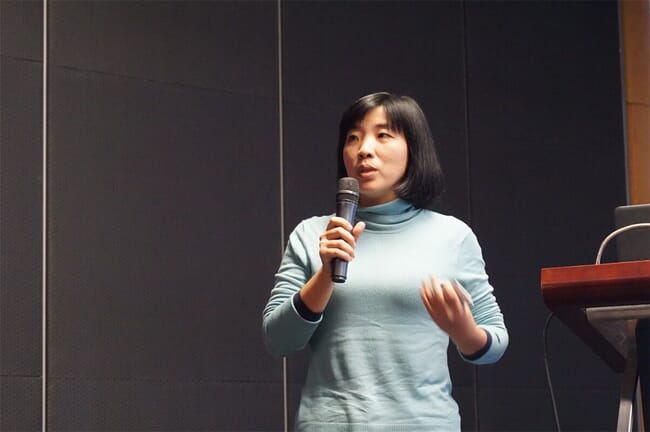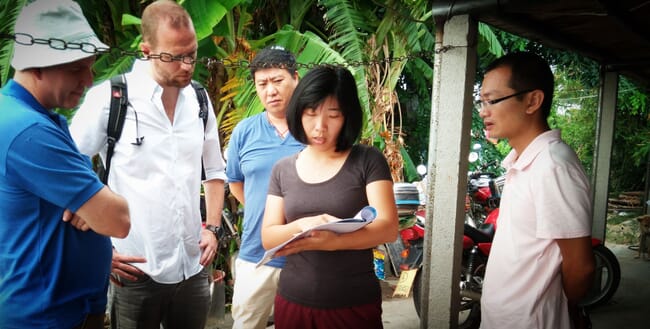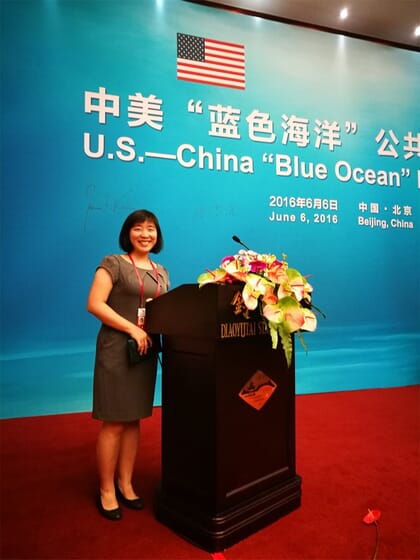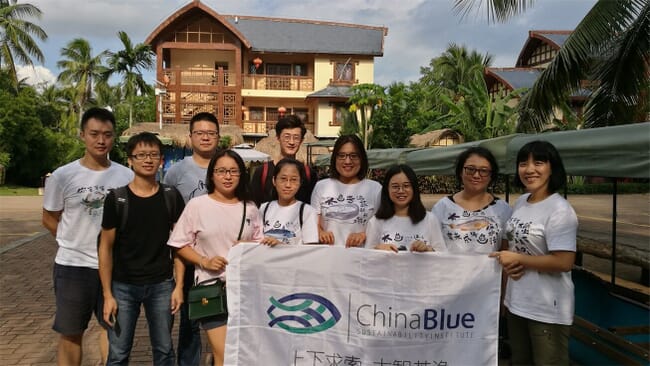Home to the world’s largest aquaculture sector, China produces more than one-third of the global fish supply, contributing more than 60 percent of global aquaculture volume and roughly half of global aquaculture value. How aquaculture develops in China and whether this development will relieve the pressure on wild fisheries are key questions going forward. Wild fisheries in China are partially used for aquaculture feed, while nonspecific and often erroneous reporting of fish production and trade makes it difficult to assess the impact of the country’s aquaculture on ocean fisheries. China’s industry also faces a host of other problems, such as the overuse of antibiotics and tainted seafood. Improving the fish supply chain is one of China’s biggest tasks today.

Han Han, the founder and CEO of China Blue, is helping China’s aquaculture sector move from production based on quantity to a new focus on quality and sustainability. Today, China Blue oversees part of an aquaculture improvement project (AIP) to revolutionise tilapia production on the Chinese island of Hainan, the country’s second largest tilapia producing region. The AIP has been directly responsible for China’s first industry-led set of standards for tilapia farming. China Blue is also behind iFISH, the first seafood sustainability database in China. iFISH allows fish companies to identify the impacts of China’s most commonly farmed fish species, whether environmental, social or economical.
Briefly describe your aquaculture career
I started my journey in aquaculture in 2010 when I became the Sustainable Fisheries Partnership’s (SFP) only staff member in China, implementing the Chinese tilapia AIP in Hainan, where I am based. I studied environmental sciences and ecology at Rutgers University in the US before returning to work as a researcher and programme manager at a local environmental science institute between 2007 and 2010. Sustainability was not a new subject for me, but I still needed to learn about fisheries and aquaculture when I started my chapter with SFP.
After working for SFP nearly for five years, I started my own organisation, China Blue, in early 2015. Nearly three years on, I have a team of 10 full-time staff, a couple of part-time consultants and a dozen interns from all over the world, drawn by our perspective and approach to improving China’s unsustainable aquaculture. I feel lucky to have such a great team, with so much support from local institutes, fish farmers and charity foundations.
What inspired you to start in aquaculture?
Ever since college, I’d dreamed about working for an NGO. Walking into SFP was one of the most wonderful things that happened to me. Not only did it bring me into aquaculture, but it also opened up a whole new world of non-profit organisations (NPOs). It’s where I began learning about aquaculture in China and the rest of the world.
I was very touched by the fact that farmers and aquaculture industry leaders are very down-to-earth people, as most of them earn their living from working hard with soil and water. They might not be well educated, but they have a sense of natural accountability to their families, the neighborhood and the environment they live in. They are also very brave to endure uncertainty and risks. Although this does not release them from their responsibility for overstocking or polluting the environment through aquaculture, I find that they are very different from industrialised workers in urban areas.

Describe a typical day in your current role
I’m the leader of the only China-based NGO that promotes sustainable aquaculture. Besides regular administrative work, my other main duties include conducting research in the field through interviews with farmers and others and analysing all kinds of information and data to understand the aquaculture industry. I also spend a third of my time fundraising and strategy-making.
Most of my team members are recent graduates, in their late twenties, who have innovative energy but not enough work experience. This means I also coach them on project implementation, management and communication. I am also a mother of two daughters who are turning 10 and 12. Unfortunately, over the past two years, I have had very little time to spend with them, play with them or talk to them. I hope this can be improved in 2018.
What’s the most interesting, inspirational experience you’ve had working in aquaculture to date?
The fact that we have created the only regional aquaculture industry-wide collaboration platform through a bottom-up development in China that occurred across the Hainan tilapia industry. It has brought a significant change to the industry and is gaining more and more trust from both industry and government. The platform has gathered each part of the supply chain and shortened the message path, thus enhancing the information sharing and supply-chain transparency. The conversation among multiple stakeholders was not easy to facilitate!
What’s the most unusual experience you’ve had in aquaculture?
The experience of founding the first NGO in the Chinese aquaculture industry. As a founder and team leader, I’ve learned a lot from this. Defining our goals, visions and values are not easy. The challenge is to believe in something intangible and keep going forward no matter how difficult the journey may be.
How important are sustainability concerns to you and how do you address them in your work?
Sustainability is the key to the long-term success of aquaculture. I believe there are three aspects of sustainability – economic, environmental and social. We are promoting sustainability ideas, concepts and tools so that they are better integrated into China’s social context. We believe that the ultimate solution lies within industries whose interests are strongly affected by sustainability issues in the long run. So, our theory of change is to empower industries and local government with a database tool to safeguard the bottom line of the environment.

What sustainability challenges have been generated by the huge expansion of China’s aquaculture sector over the last 20 years?
Aquaculture in China is facing a lack of good water resources, limited land for pond aquaculture, significant losses caused by endless disease and subsequently a high risk of chemical residue. These have impeded aquaculture development, despite fast-growing volume and market demand in China. There are hundreds of farmed species in China’s aquaculture, most of which are cultured by smallholders. Accurate information about each species’ yield and distribution is always a challenge, and creates difficulty in transparency and traceability of aquaculture supply chains.
What new technical or product innovation do you think has the most potential to change aquaculture?
Breeding, feeding nutrients, vaccines or medicine that cure relevant diseases are very important milestones in aquaculture development. Cost-effective vaccines, for example, could be a game-changer but they still need to be thoroughly tested in the field. More importantly, especially for those in developing countries, it is very valuable to have technology and products that help farmers connect, communicate and cooperate with each other and those in the supply chain. This will significantly reduce the cost of information sharing, disclosing and reporting. It will help farmers build up the trust and coordination that will lower business costs.
Can you tell us about iFISH? How does it work, and how much interest has it generated in China and around the world?
We were inspired by western countries’ sustainability rating schemes and certification approaches, but also fully aware of the limitations of such individual farm-based assessment methods. We wanted to create a unique method that best fitted the socio-economic context of the Chinese seafood industry. The database contains information on mainly domestic species and farming models. Evaluations are given to a region with those featured models or species, where they share the same water resources and governance bodies, and partially share the supply chain. The output of the evaluation will provide regional aquaculture managers (such as government officers, farm managers, farmers, industry association managers) with science-based recommendations to help enhance their capacity towards sustainability. It contains qualitative and quantitative indices, both of which are still under development. The outputs will also benefit Chinese retailers and buyers who are interested in sourcing more responsibly and sustainably.
Are there any individuals or organisations in aquaculture who you’ve found particularly inspirational?
I am very grateful to SFP where I found the NGO model and this great field – sustainable fisheries and aquaculture. I was lucky to be mentored by Howard Johnson and Anton Immink, my two supervisors, and I appreciate the trust, kindness and openness of the SFP’s founder and CEO, Jim Cannon. They are my career models that inspire me to continue on my own journey.
Have you faced any particular challenges as a woman in aquaculture?
Most people working in this field in China are men. It sometimes does create a bit of trouble when people don’t take you seriously. But I think it can also be an advantage – as it gives you the chance to stand out. I also think the key is to act approachable. For example, when contacting men for the first time, show a slight weakness or take a lower position so they don’t feel threatened.
How are women addressing inequalities in aquaculture in your region and have you seen the opportunities improve in recent years?
In general, Chinese women are lucky to have a high degree of equality but there are differences in the types of duties men and women have in aquaculture. Women in aquaculture might not be very visible, but they are very important participants, contributors and even decision makers. In fact, most small-scale farms are operated by a couple, and the woman is the one in charge of financing. In a sense, she is the actual boss!
What advice would you give to women looking to start a career in the aquaculture sector?
If you choose this sector, you have to really like it. Then, you need to be patient and persistent.

What would be your dream role in aquaculture and do you think it’s realistic to achieve?
I think my current role is my best position in aquaculture. It’s a new role, at least to the Chinese aquaculture industry and government. We are looking at how to maximise the impacts of this role. Every day I have now is a new day full of challenges, but worth it.
What outstanding challenge would you most like to solve?
As the leader of a young NGO team working towards sustainable aquaculture development in China, I’d like to overcome my own weaknesses, take control and think rationally. As for challenges in aquaculture, one is the disconnection between different parts of the supply chain. There can be a lack of mutual understanding between them, or a lack of trust, or a lack of efficient communication and collaboration. I think these missing parts are critical to a more mature and modern aquaculture industry in China, but unfortunately, the industry, academia and the government have all failed in fixing these problems in isolation. They need to work together in a better way, and that is where I believe an NGO like China Blue can help to facilitate their collaboration and address this challenge.







